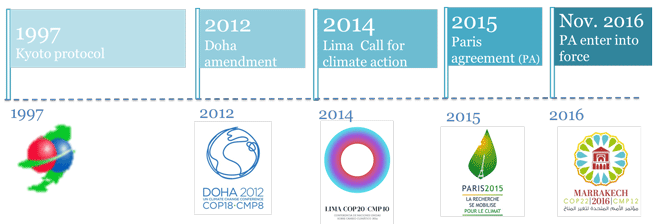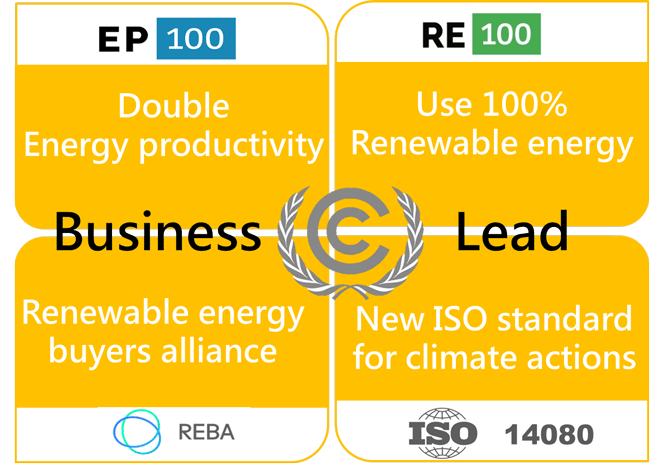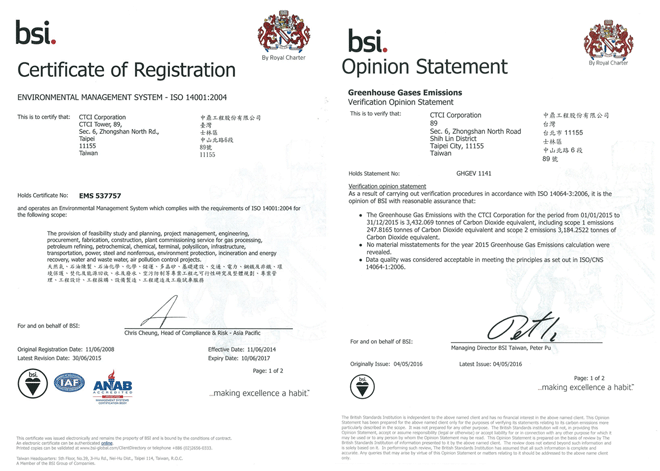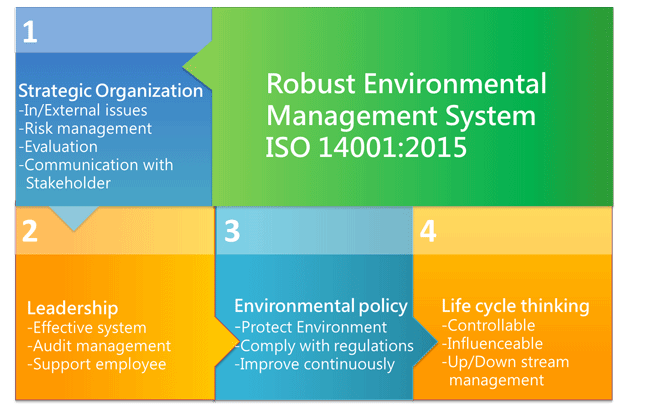Sustainable Future
永續未來
A Win-Win Situation Between Enterprises and the Environment
CTCI’s Sustainable Management Actions
UNFCC was established in 1922 to prevent dangerous human interference with the climate system. Since the Kyoto Protocol was adopted in 1977, significant carbon reducing actions have been brought up at the annual conference of the parties (COP) more frequently. The Paris agreement set a goal to limit rising temperatures below 2 degrees Celsius, and it is scheduled to replace the Kyoto protocol in 2020. As a result, COP22 held in 2016 aims to develop methods that can assist countries to meet the goal of the Paris agreement. Discovering opportunities and creating value in this challenge brought about by Paris Agreement will be a critical issue for every business. CTCI has long been committed to introducing and developing green engineering technologies. From perspectives of design, procurement, construction, trial run, operation, and decommissioning, we offer businesses economic and viable energy-saving solutions. With the global trend of actively responding to climate change and decreasing greenhouse gas emissions, we have implemented carbon inventory, carbon disclosure and environmental management system which enhance our climate adaptation while mitigating climate change.

Figure 1- Key steps of international climate action
Businesses Play a Crucial Role in Climate Action
According to the report from the United Nations and KPMG, 5 critical challenges were stressed in the opening statement of UNFCCC: climate financial support, the ambition of reducing carbon emission, vulnerable community protection, developing countries’ resilience and collaboration between government and non-state actors (e.g., businesses). Notably, businesses are included in one of the critical roles in combating climate change. How can businesses partake in global climate actions? There are many business-led activities at COP22; for example, world-leading corporations focus on infusing their business models and investments on Business and Industry day to address the issue. In addition, the risk and chance of energy usage and renewable energy purchase are popular issues on Energy Day during the conference. Businesses have committed to join RE100 and EP100 to show resolution on carbon reduction. In addition, a new business-led initiative, the Renewable Energy Buyers Alliance (REBA), may be established for enhancing the renewable energy supply–demand chain. Markedly, the small island developing states (SIDS) Lighthouse Initiative launched in 2015 will be supported by UAE, which announced an investment of USD 50 million for Caribbean states’ renewable energy transformation. To support the need of businesses’ climate adaptation, new ISO standard 14080 for greenhouse gas management and related activities was published at COP22. ISO 14080 provides guidance for corporations to assure their climate actions and related methodologies and a capability review.

Figure 2- Climate mitigation action led by businesses
Carbon Inventory and Disclosure
CTCI has been publishing the Corporate Social Responsibility Report since 2008 and has established a cross-department environmental protection group that enhances energy savings and carbon reduction in both operating sites and our service. As the first and the only Taiwanese construction and engineering company that has become a member of the Dow Jones Sustainability Indices for 2 consecutive years, climate change and strategy is one of CTCI’s sustainable issues. It is strong evidence that we take climate change seriously. To show our resolution to mitigate climate change and clarify carbon risk and change, CTCI has conducted greenhouse gas inventory since 2012. The results have been verified by a third party. Emissions will continue to be checked annually to serve as the basis for future carbon reduction and carbon management. Currently, the checkup range of scope 1 and scope 2 covers CTCI's headquarters building. Based on CTCI’s industry characteristics, the greenhouse gas inventory will be gradually implemented in all major construction sites. Emission in scope 3 will also be a focus for greenhouse gas checkup in the future. This year, CTCI will complete the Carbon Disclosure Project (CDP) climate change questionnaire, the largest international sustainable evaluation. We expect to sustain our reliability via friendly disclosure.
Environment Management System (EMS)
To ensure environmental responsibility while succeeding in business, CTCI introduced ISO14001:2004 EMS in 2006 and has been verified by a third party every year. ISO published ISO14001:2015 in September 2015 to help businesses prevent and control environmental risks resulting from recent global climate change. Announced by IAF and ISO/CASCO, the 3-year transition will end on September 14, 2018. CTCI will receive verification of the latest version by the end of this year and will bolster our EMS with ISO14001:2015, a more sustainable standard.


1. Strategic Organization Plan
To guide businesses to achieve a dynamic and robust sustainable goal, the ISO 14001:2015 system enlarged the applicable scope to include the external impact of the organization. The first step for businesses to set up EMS is to understand internal/external issues related to their own mission and vision. The issues should include the corporate environmental condition, identification of environmental market change and external threats. After that, businesses could introduce risk management into the EMS and develop a strategy according to different risk levels. In addition to monitoring and measurement, the new EMS includes analysis and evaluation for businesses to holistically understand the performance of the system. Owing to the rising environmental awareness in the post-industrial era, the environmental impact during production/manufacturing has become a major concern globally. ISO 14001:2015 emphasizes appropriate communication with stakeholders. To meet stakeholders’ expectations, businesses can work on the enquired issues, frequency, time, and communication type for every stakeholder. CTCI has identified our stakeholders and set up communication details in our first CSR report. The issues of stakeholders will be combined into the planning of EMS to elevate the environmental communication quality.
2. Leadership by Top Management
The new EMS has a higher expectation of top management who could ensure the effectiveness and compatibility of the system through participating in the establishment of EMS. Top management could also convene an audit management conference to inspect corporate environmental performance and promote continual improvement. Furthermore, leadership and support of employees will result in a perfect integration of environmental management requirements and organizational business. CTCI regularly schedules audit management conferences to assure top management support. The conference is held by the Group Vice Chairman and is attended by the top supervisor of each business. The corporate performance of environmental management is effectively reviewed in the conference to achieve continual improvement.
3. Escalation of Environment Policy Commitment
One critical change of ISO14001:2015 is the range of environmental policy, which includes environmental protection rather than the original focus on pollution prevention. In other words, businesses should take more action on multi-dimensional environmental protection—for instance, sustainable resources, climate mitigation and adaptation, biodiversity and ecological system protection. In addition, environmental policy can be regarded as a proof of leadership by top management. Furthermore, the environmental policy plays an important role in communication with stakeholders, and the standard is also accessible to stakeholders. We developed 5 beliefs about environmental protection before the latest EMS was released: Provide professional services that meet environmental requirements, energy savings, carbon reduction, pollution prevention, and work with interested parties to pursue sustainable development.
4. Life Cycle Thinking
The international trends in environmental protection have led to extensive applications of product/service life cycle assessment in environmental management. The new EMS adopts life cycle thinking, which means businesses should identify significant environmental aspects and the related environmental impact of the entire life cycle. The entire life cycle is composed of raw material, manufacturing production, transportation, utilization and recycling/disposal. The organization should identify the steps that can be controlled or influenced and then strategize to achieve both 3E (economic, environment, energy) and 4R (reduce, recycle, reuse, regenerate). CTCI has conducted evaluations of suppliers and subcontractors for years, and we will adopt life cycle thinking in further management considerations.
According to the UN world commission on Environment and Development document “our common future”, the definition of sustainable development is a development that meets the needs of the present without compromising the ability of future generations to meet their own needs. Economic, social, and environmental elements are essential for achieving these goals. In addition, environmental responsibility is included in corporate social responsibility. CTCI has provided service with professional engineering techniques and will keep progressing in our ongoing environmental management to carry out our environmental policy and our belief in green engineering to create a win-win situation between enterprises and the environment.
